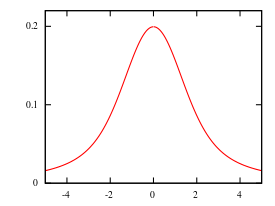Slash distribution
|
Probability density function  | |
|
Cumulative distribution function  | |
| Parameters | none |
|---|---|
| Support | |
| CDF | |
| Mean | Does not exist |
| Median | 0 |
| Mode | 0 |
| Variance | Does not exist |
| Skewness | Does not exist |
| Ex. kurtosis | Does not exist |
| MGF | Does not exist |
| CF | |
In probability theory, the slash distribution is the probability distribution of a standard normal variate divided by an independent standard uniform variate.[1] In other words, if the random variable Z has a normal distribution with zero mean and unit variance, the random variable U has a uniform distribution on [0,1] and Z and U are statistically independent, then the random variable X = Z / U has a slash distribution. The slash distribution is an example of a ratio distribution. The distribution was named by William H. Rogers and John Tukey in a paper published in 1972.[2]
The probability density function (pdf) is
where φ(x) is the probability density function of the standard normal distribution.[3] The result is undefined at x = 0, but the discontinuity is removable:
The most common use of the slash distribution is in simulation studies. It is a useful distribution in this context because it has heavier tails than a normal distribution, but it is not as pathological as the Cauchy distribution.[3]
Differential equation
The pdf of the slash distribution is a solution of the following differential equation:
References
- ↑ Davison, Anthony Christopher; Hinkley, D. V. (1997). Bootstrap methods and their application. Cambridge University Press. p. 484. ISBN 978-0-521-57471-6. Retrieved 24 September 2012.
- ↑ Rogers, W. H.; Tukey, J. W. (1972). "Understanding some long-tailed symmetrical distributions". Statistica Neerlandica. 26 (3): 211–226. doi:10.1111/j.1467-9574.1972.tb00191.x.
- 1 2 "SLAPDF". Statistical Engineering Division, National Institute of Science and Technology. Retrieved 2009-07-02.
![]() This article incorporates public domain material from the National Institute of Standards and Technology website http://www.nist.gov.
This article incorporates public domain material from the National Institute of Standards and Technology website http://www.nist.gov.